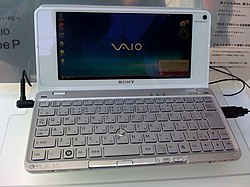Description
The Sony Vaio P series features an 8" LED-backlit display with native resolution of 1600x768, coupled with Intel GMA 500 integrated graphics, an Intel Atom Silverthorne Z5x0 CPU with Intel Poulsbo US15W chipset, and up to 2GB of DDR2 memory. Notably, the P series sports non-upgradeable [4] RAM that is soldered to the motherboard, with some models including just 1GB of RAM. [5] It uses a pointing stick in the keyboard as its pointing device. Exact specs vary by region. An integrated "Motion Eye" webcam (optional in some models) is located on the upper right corner of the display bezel. Built-in GPS (some models), Bluetooth, 802.11 b/g/n wireless and 3G or HSDPA mobile broadband comprise its connectivity options. Like most ultraportables and netbooks, an internal optical drive is not present.
At launch, the pre-installed operating system was one of the 32-bit versions of Windows XP, which has lower resource requirements than Windows Vista. Several people have succeeded in installing various versions of Linux on the Vaio P, most notably Ubuntu Linux (Version 9.04, Jaunty). Ubuntu is arguably the best alternative due to its ease of installation and configuration, and the fact that it allows for full 3D graphics to be utilized. [6] Since the release of Windows 7, the P series now ships with that OS installed. The P series has been criticized for poor performance in part due to the excessive pre-installed software, but also because of the poor performance of the integrated graphics. [7]
Compared with most other Intel Atom-based netbooks, the P series was considerably more expensive. However, the Atom Silverthorne platform adopted by the P series sported lower power consumption and higher-clocked processor options compared to the more common Diamondville platform. Later models of the Vaio P included these faster CPUs. In addition, the P series is the lightest device in its class, weighing roughly the same as the Apple iPad 2 tablet and less than all 10" netbooks, and the 7" Asus Eee PC models. The 1600x768 resolution of the P series' 8" display is also comparable to that of much larger laptops, such as the 12.1" Thinkpad X200s and its 1440x900 resolution.
May 2010 update
The VPC-P11 series launched in May 2010 featured a refreshed exterior, an accelerometer to enable switching from landscape to portrait mode, a tiny 16mmx16mm touchpad built into the LCD bezel, and a choice of five colours - 'electric orange, neon green, hot pink, icy white and classic black'. [8] In addition, a button was added to instantly switch the screen to 1280x600 resolution, in order to make text more readable, as well as a digital compass, ambient light sensor, and higher-capacity battery (2500mAh). [9]
The 2010 revision was the last iteration of the P series, with Sony discontinuing the product in 2011. The P series clamshell format was incorporated in Sony's Tablet P, which was released in November 2011.
USA models
(note color codes: /G - Emerald Green, /Q Glossy Black, /R Sangria Red, /W Dove White, /N gold, /P /PI pink, /D white, /B black)
Launch dates
VGN-P500 series - January/February 2009
VGN-P600 series - July 2009
VGN-P700 series - October 2009
VPC-P11 series - May 2010
| Model | Color | Processor | Memory | Storage Drive | Operating System | Release Price (USD) |
|---|
| VGN-P530H | Green/Black/Red/White | Intel Atom Z520 @ 1.33 GHz | 2 GB DDR2 | 60 GB HDD | Windows Vista Home Basic 32-bit | $899.99 |
| VGN-P530N | 2 GB DDR2 | Windows Vista Business 32-bit | $1099.99 |
| VGN-P588E | Green/Gold/Black/Red/White | 2 GB DDR2 | 64 GB SSD | Windows Vista Home Premium 32-bit | $1,199.99 |
| VGN-P598E | Black/Red | Intel Atom Z530 @ 1.33 GHz | 2 GB DDR2 | 128 GB SSD | $1,499.99 |
| VGN-P599E | Black | Intel Atom Z540 @ 1.86 GHz | 2 GB DDR2 | 256 GB SSD | $1,899.99 |
| VGN-P688E | Black/White | Intel Atom Z520 @ 1.33 GHz | 2 GB DDR2 | 64 GB SSD | $999.99 |
| VGN-P698E | Black | Intel Atom Z530 @ 1.6 GHz | 2 GB DDR2 | 128 GB SSD | $1,499.99 |
| VGN-P720K | Red | Intel Atom Z520 @ 1.33 GHz | 2 GB DDR2 | 80 GB HDD | Windows 7 Home Premium 32-bit | $849.99 |
| VGN-P788K | Gold | Intel Atom Z530 @ 1.6 GHz | 2 GB DDR2 | 64 GB SSD | $999.99 |
| VGN-P798K | Black | Intel Atom Z540 @ 1.86 GHz | 2 GB DDR2 | 128 GB SSD | $1,499.99 |
| VGN-P799L | Intel Atom Z550 @ 2 GHz | 2 GB DDR2 | 256 GB SSD | $1,899.99 |
| VPC-P111KX | Black/Pink/Green/White | Intel Atom Z530 @ 1.6 GHz (no GPS) | 2 GB DDR2 | 64 GB SSD | $799.99 |
| VPC-P113KX | Black/Pink/Green/White/Orange | 2 GB DDR2 | 128 GB SSD | $899.99 |
| VPC-P114KX | Black | 2 GB DDR2 | $999.99 |
| VPC-P116KX | Pink | Intel Atom Z540 @ 1.87 GHz (with GPS) | 2 GB DDR2 | $1499.99 |
| VPC-P118KX | Black | Intel Atom Z550 @ 2 GHz (with GPS) | 2 GB DDR2 | 256 GB SSD | $1499.99 |
This page is based on this
Wikipedia article Text is available under the
CC BY-SA 4.0 license; additional terms may apply.
Images, videos and audio are available under their respective licenses.
